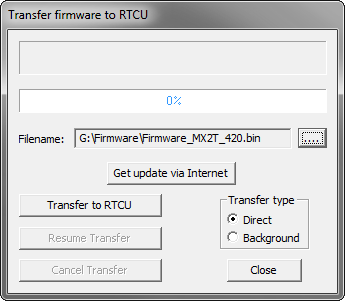By using "Transfer firmware", it is possible to upload a new firmware revision to a connected RTCU. It is possible to select a file, or to get a list of available versions, by clicking the "Get update via Internet". This requires you to have a connection to the internet.

Depending on the type of RTCU and/or the connection type, you can choose to upload the firmware either as a "Direct" upload or as a "Background" upload. By using a Direct upload, you will halt the execution of the running application. Update mode will then be entered. If using the Background upload, the running application will continue to run during the upload. When the upload has finished the actual "switch" to the new firmware, this process will be finished when the device resets next time. One other advantage of the Background upload is that a failed/disconnected upload attempt can be resumed at a later time. When using the Background upload, the Voice section cannot be transferred, and the current Voice data in the device may be overwritten as the device uses the Voice flash memory for its operation. This means that if the application contains Voice data, and the background upload is used, the Voice data will have to be transferred separately after the Background upload has finished. Also see the verCheckUpgrade() function-block.
If you press the "Get update via Internet", you will be presented with a list of available firmware files as seen below:

It is very important that you select the correct file.
For Linux-based RTCU devices (LX / NX) there are several types of firmware files:
Runtime-Firmware.
This is the primary firmware that implements most of the functionality of the RTCU platform. This can best be compared with the single firmware on non-Linux based devices. This firmware file is most frequently updated.
System-Firmware.
This main firmware includes the complete Linux system and all the necessary files to run the system. It also includes a runtime firmware that can later be upgraded. This firmware is not frequently updated.
Monitor-Firmware.
This firmware is a "backup" firmware used if the System-firmware is not present or is under update. This firmware is rarely updated.